Polyoxyethylene Group-Dependent Surface Properties and Aggregation Behavior in Oleyl-Based Sulfosuccinate Systems
Abstract
1. Introduction
2. Results
2.1. Structure Identification
2.2. Surface Activity
2.2.1. Equilibrium Surface Tension
2.2.2. Dynamic Surface Tension
2.3. Aggregation Behavior
2.4. Foaming Behavior
2.5. Wetting Ability
2.6. Liquid Crystal Emulsion
3. Materials and Methods
3.1. Materials
3.2. Synthesis of MS-OEn
3.3. Preparation of Emulsion
3.4. Characterization
3.4.1. Structural Characterization
3.4.2. Surface Tension Measurement
3.4.3. Transmission Electron Microscopy (TEM)
3.4.4. Foam Properties Measurement
3.4.5. Wetting Ability Measurement
3.4.6. Polarizing Microscope (POM) Measurement
4. Conclusions
Supplementary Materials
Author Contributions
Funding
Institutional Review Board Statement
Informed Consent Statement
Data Availability Statement
Conflicts of Interest
References
- Liu:, Q.C.; Ren, Z.H.; Zhang, Q.H.; Xu, J.H.; Deng, Z.P.; Wu, Q.R.; Zhang, Z.X.; Lu, B.; Guo, C.J. Quasi-binary mixture of anionic disodium poly (ethylene glycol) sulfosuccinate and nonionic diethanolamide in aqueous solution: Micellization and wetting behavior. J. Mol. Liq. 2024, 415, 126353–126363. [Google Scholar] [CrossRef]
- Yang, C.; Li, T.; Zhu, T.; Duan, X.; Chen, Y.; Xu, Y.; Chen, F.; Liu, K. Mass transfer process of peanut protein extracted by bis(2-ethylhexyl) sodium sulfosuccinate reverse micelles. Grain Oil Sci. Technol. 2024, 7, 60–67. [Google Scholar] [CrossRef]
- Cai, H.; Zheng, Y.; Wang, H.; Zhang, Y.; Lai, L.; Xie, Q.; Fang, L. Synthesis and physiochemical properties of poly (ethylene glycol)-octanol sulfosuccinates. J. Mol. Liq. 2018, 265, 556–564. [Google Scholar] [CrossRef]
- Fajalia, A.I.; Antoniou, E.; Alexandridis, P.; Tsianou, M. Self-assembly of sodium bis(2-ethylhexyl) sulfosuccinate in aqueous solutions: Modulation of micelle structure and interactions by cyclodextrins investigated by small-angle neutron scattering. J. Mol. Liq. 2015, 210, 125–135. [Google Scholar] [CrossRef]
- Delgado-Zamarreño, M.M.; Sánchez-Pérez, A.; González Maza, I.; Hernández-Méndez, J. Micellar electrokinetic chromatography with bis(2-ethylhexyl) sodium sulfosuccinate vesicles: Determination of synthetic food antioxidants. J. Chromatogr. A 2000, 871, 403–414. [Google Scholar] [CrossRef] [PubMed]
- Matsuoka, K.; Noshiro, N.; Kuroki, H.; Tsuyuzaki, K.; Hashimoto, G. Vesicle formation of disodium lauryl sulfosuccinate. J. Mol. Liq. 2022, 348, 118422–118428. [Google Scholar] [CrossRef]
- Patil, H.V.; Kulkarni, R.D.; Wadaan, M.A.; Badgujar, N.P.; Nagaraj, K.; Raja, K.; Ghodake, G.S. Synthesis and characterization of oleyl-based green surfactants for enhanced pigment dispersion. J. Indian Chem. Soc. 2025, 102, 101583–101591. [Google Scholar] [CrossRef]
- Deepika; Tyagi, V.K. Sulfosuccinates as mild surfactants. J. Oleo Sci. 2006, 55, 429–439. [Google Scholar]
- Wibel, R.; Knoll, P.; Le-Vinh, B.; Kali, G.; Bernkop-Schnürch, A. Synthesis and evaluation of sulfosuccinate-based surfactants as counterions for hydrophobic ion pairing. Acta Biomater. 2022, 144, 54–66. [Google Scholar] [CrossRef]
- Okamura, S.; Aono, K.; Yokoyama, M.; Shiba, H.; Suzuki, F.; Okano, T.; Iimura, K.-I. Influence of dialkyl chains of sulfosuccinate sodium salt surfactant on interfacial tension between hydrophobic material and water. Colloid Surface A 2024, 681, 132770–132776. [Google Scholar] [CrossRef]
- Song, L.; Cong, Y.; Wang, M.; Ge, X.; Zhang, Z. Incorporation of disodium alkyl polyoxyethylene ether sulfosuccinate inside styrene droplets: Mechanism and its application for preparation of multihollow polymer spheres. J. Colloid Interface Sci. 2008, 322, 231–236. [Google Scholar] [CrossRef] [PubMed]
- Weil, J.K.; Stirton, A.J.; Bistline, R.G. Synthetic detergents from animal fats. The sulfation of tallow alcohols. J. Am. Oil Chem. Soc. 1954, 31, 444–447. [Google Scholar] [CrossRef]
- Egan, R.R.; Earl, G.W.; Ackerman, J. Properties and uses of some unsaturated fatty alcohols and their derivatives. J. Am. Oil Chem. Soc. 1984, 61, 324–329. [Google Scholar] [CrossRef]
- Wang, X.; Yang, X.; Sun, Y.; Guo, C.; Li, P.; Li, J. Effect of oxyethylene groups on adsorption properties of fatty alcohol polyoxyethylene ether sodium sulfate with narrow ethylene oxide distribution. Tenside Surf. Det. 2020, 57, 469–478. [Google Scholar] [CrossRef]
- Jin, Z.; Xu, Z.; Gong, Q.; Zhao, S.; Yu, J. Synthesis and properties of anionic surfactants containing oxyethylene group or/and branched tail. J. Dispersion Sci. Technol. 2011, 32, 898–902. [Google Scholar] [CrossRef]
- Ling, T.; Jiang, Z.; Yang, X.; Li, P.; Li, J.; Ren, X.; Guo, C. Synthesis, surface properties, aggregation behavior of oleyl ether sulfates and their application to liquid crystal emulsion. Colloid Surface A 2022, 642, 128655–128665. [Google Scholar] [CrossRef]
- Zhao, G.; Zhu, B. Principles of Surfactant Action; China Light Industry Press: Beijing, China, 2003; pp. 140–180. [Google Scholar]
- Guoyong, W.; Zhiping, D.; Qiuxiao, L.; Wei, Z. Carbohydrate-modified siloxane surfactants and their adsorption and aggregation behavior in aqueous solution. J. Phys. Chem. B 2010, 114, 6872–6877. [Google Scholar] [CrossRef]
- Yang, W.; Cao, Y.; Ju, H.; Wang, Y.; Jiang, Y.; Geng, T. Amide gemini surfactants linked by rigid spacer group 1,4-dibromo-2-butene: Surface properties, aggregate and application properties. J. Mol. Liq. 2021, 326, 115339–115349. [Google Scholar] [CrossRef]
- Ling, T.; Li, P.; Yang, X.; Li, J.; Jiang, Z.; Ren, X.; Guo, C. Preparation, adsorption and aggregation behavior of sodium oleyl sulfate with high double bond retention. J. Mol. Liq. 2021, 342, 117506–117515. [Google Scholar] [CrossRef]
- Nusselder, J.J.H.; Engberts, J.B.F.N. Toward a better understanding of the driving force for micelle formation and micellar growth. J. Colloid Interface Sci. 1992, 148, 353–361. [Google Scholar] [CrossRef]
- Hou, S.; Wang, Y.; Li, J.; Wang, Z.; Jiang, Y.; Geng, T. Effects of the number of cationic sites on the surface/interfacial activity and application properties of quaternary ammonium surfactants. Colloid Surface A 2023, 656, 130523–130534. [Google Scholar] [CrossRef]
- Zhang, M.; Ning, B.; Bai, Y.; Tai, X.; Wang, G. Solution properties of mixed system containing butynediol-ethoxylate polysiloxanes and polyether trisiloxane surfactant. Colloid Surface A 2021, 41, 100367–100374. [Google Scholar] [CrossRef]
- Zhao, J.X.; Liu, F.; Xie, D.H. Vesicle aggregation based on hydrophobic interactions. Colloid. Polym. Sci. 2015, 293, 3633–3639. [Google Scholar] [CrossRef]
- Yeh, V.; Goode, A.; Eastham, G.; Rambo, R.P.; Inoue, K.; Doutch, J.; Bonev, B.B. Membrane stability in the presence of methacrylate esters. Langmuir 2020, 36, 9649–9657. [Google Scholar] [CrossRef]
- Okahata, Y.; Kunitake, T. Formation of stable monolayer membranes and related structures in dilute aqueous solution from two-headed ammonium amphiphiles. J. Am. Chem. Soc. 1979, 101, 5231–5234. [Google Scholar] [CrossRef]
- Kunitake, T.; Okahata, Y.; Shimomura, M.; Yasunami, S.; Takarabe, K. Formation of stable bilayer assemblies in water from single-chain amphiphiles. Relationship between the amphiphile structure and the aggregate morphology. J. Am. Chem. Soc. 1981, 103, 5401–5413. [Google Scholar] [CrossRef]
- Li, P.; Ren, P.; Wang, S.; Wang, J.; Sun, Z.; Sun, J.; Gu, W. Adsorption and aggregation behaviors of oleyl alcohol-based extended surfactant and its mixtures. Molecules 2024, 29, 2570. [Google Scholar] [CrossRef]
- del Burgo, P.; Aicart, E.; Llorca, O.; Junquera, E. Cationic prevesicle and vesicle nanoaggregates: An experimental and theoretical study. J. Phys. Chem. B 2006, 110, 23524–23539. [Google Scholar] [CrossRef]
- Regev, O.; Khan, A. Alkyl chain symmetry effects in mixed cationic–anionic surfactant systems. J. Colloid Interface Sci. 1996, 182, 95–109. [Google Scholar] [CrossRef]
- Vlachy, N.; Merle, C.; Touraud, D.; Schmidt, J.; Talmon, Y.; Heilmann, J.; Kunz, W. Spontaneous formation of bilayers and vesicles in mixtures of single-chain alkyl carboxylates: Effect of ph and aging and cytotoxicity studies. Langmuir 2008, 24, 9983–9988. [Google Scholar] [CrossRef]
- Zhang, Q.; Li, Y.; Song, Y.; Fu, H.; Li, J.; Wang, Z. Properties of vesicles formation of single-chain branched carboxylate anionic surfactant in aqueous solutions. J. Mol. Liq. 2017, 243, 431–438. [Google Scholar] [CrossRef]
- Sakai, T.; Ikoshi, R.; Toshida, N.; Kagaya, M. Thermodynamically stable vesicle formation and vesicle-to-micelle transition of single-tailed anionic surfactant in water. J. Phys. Chem. B 2013, 117, 5081–5089. [Google Scholar] [CrossRef]
- Roy, A.; Maiti, M.; Roy, S. Spontaneous formation of vesicles by sodium 2-dodecylnicotinate in water. Langmuir 2012, 28, 12696–12703. [Google Scholar] [CrossRef]
- Caria, A.; Khan, A. Phase behavior of catanionic surfactant mixtures: Sodium bis(2-ethylhexyl)sulfosuccinate−didodecyldimethylammonium bromide−water system. Langmuir 1996, 12, 6282–6290. [Google Scholar] [CrossRef]
- Li, X.G.; Liu, F.M. Phase separation of the aqueous solution and the surface activity of oxyethylenated cationic-anionic surfactants. Colloid Surface A 1995, 96, 113–119. [Google Scholar] [CrossRef]
- Hu, X.; Li, Y.; He, X.; Li, C.; Li, Z.; Cao, X.; Xin, X.; Somasundaran, P. Structure–behavior–property relationship study of surfactants as foam stabilizers explored by experimental and molecular simulation approaches. J. Phys. Chem. B 2012, 116, 160–167. [Google Scholar] [CrossRef]
- Wang, J.; Nguyen, A.V.; Farrokhpay, S. A critical review of the growth, drainage and collapse of foams. Adv. Colloid Interface Sci. 2016, 228, 55–70. [Google Scholar] [CrossRef]
- Zhao, G.; Dai, C.; Zhang, Y.; Chen, A.; Yan, Z.; Zhao, M. Enhanced foam stability by adding comb polymer gel for in-depth profile control in high temperature reservoirs. Colloid Surface A 2015, 482, 115–124. [Google Scholar] [CrossRef]
- Zhou, Z.H.; Zhang, Q.; Wang, H.Z.; Xu, Z.C.; Zhang, L.; Liu, D.D.; Zhang, L. Wettability of a ptfe surface by aqueous solutions of zwitterionic surfactants: Effect of molecular structure. Colloid Surface A 2016, 489, 370–377. [Google Scholar] [CrossRef]
- Terescenco, D.; Picard, C.; Clemenceau, F.; Grisel, M.; Savary, G. Influence of the emollient structure on the properties of cosmetic emulsion containing lamellar liquid crystals. Colloid Surface A 2018, 536, 10–19. [Google Scholar] [CrossRef]
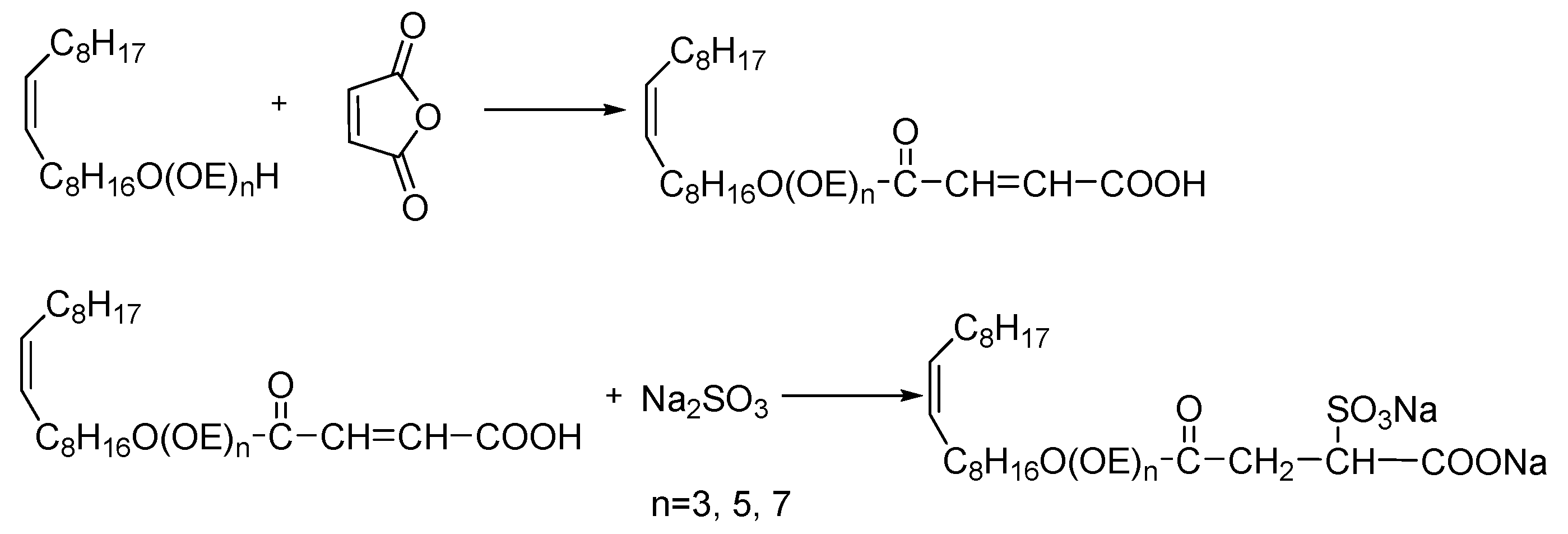
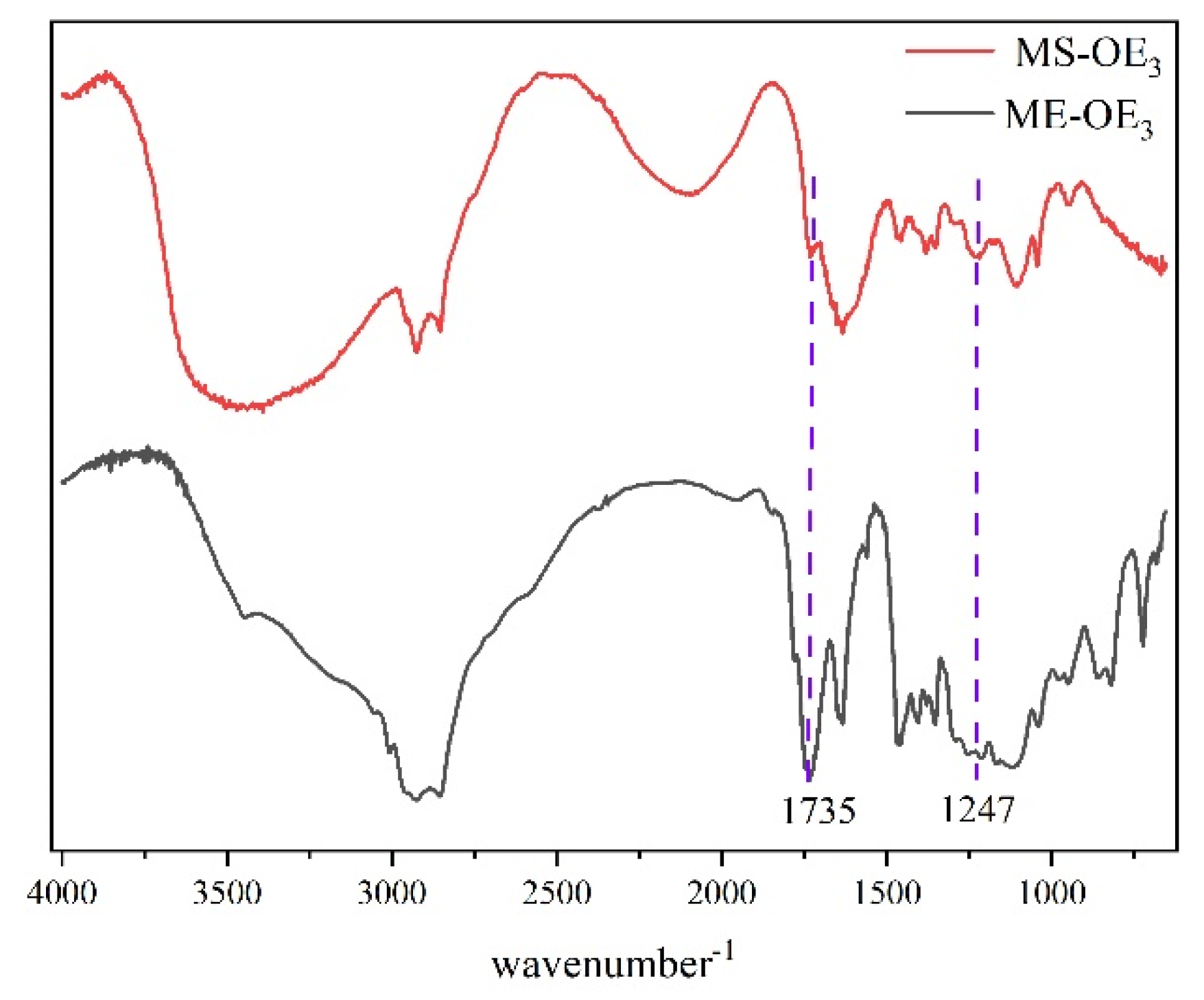
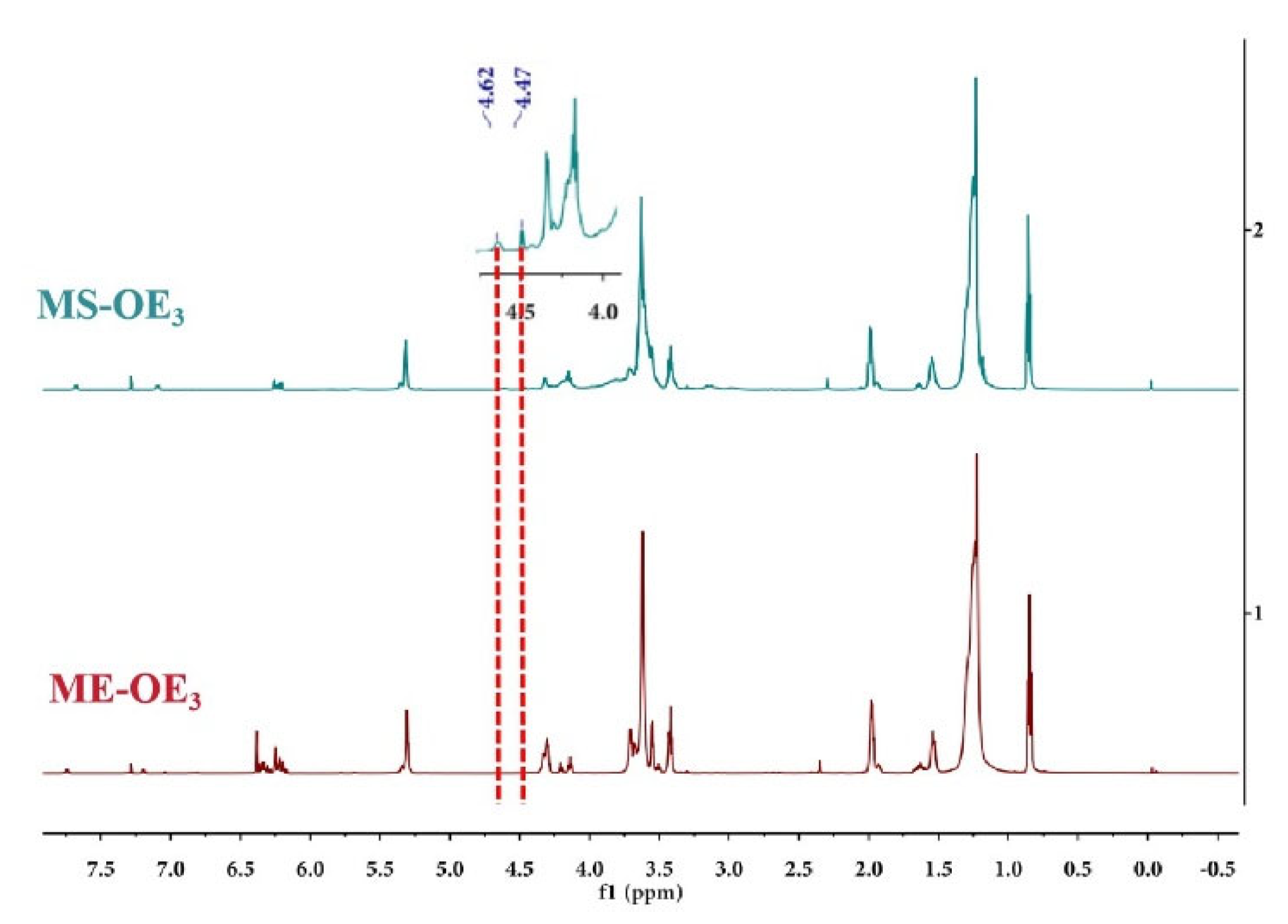
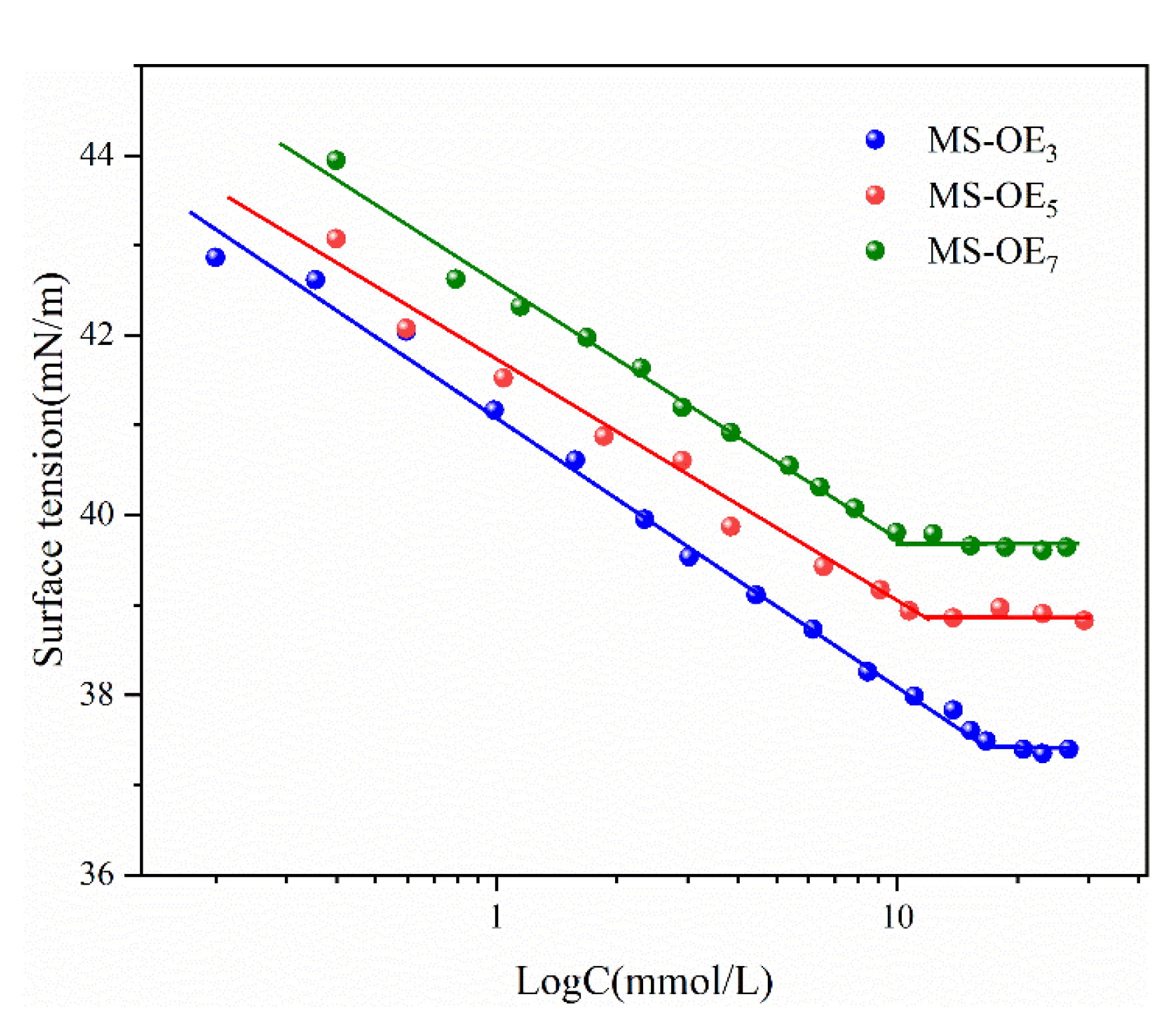
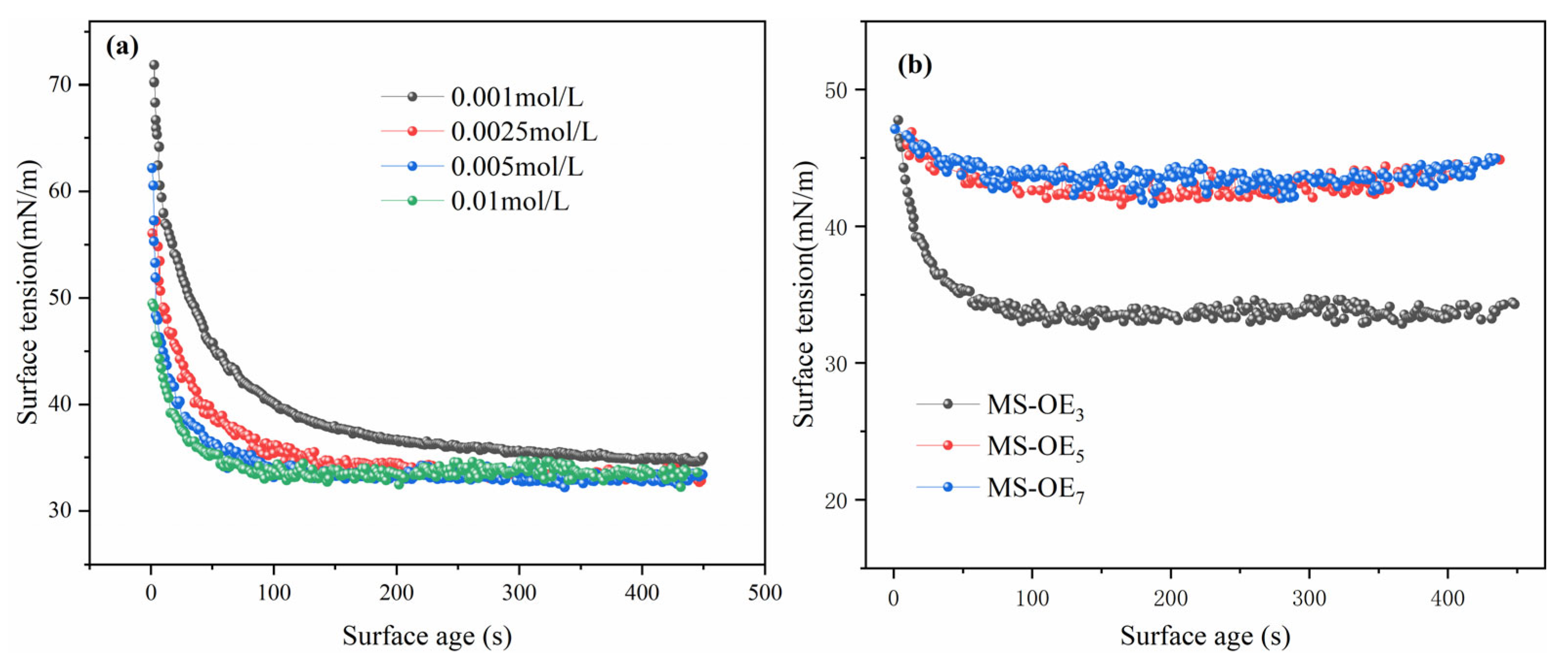
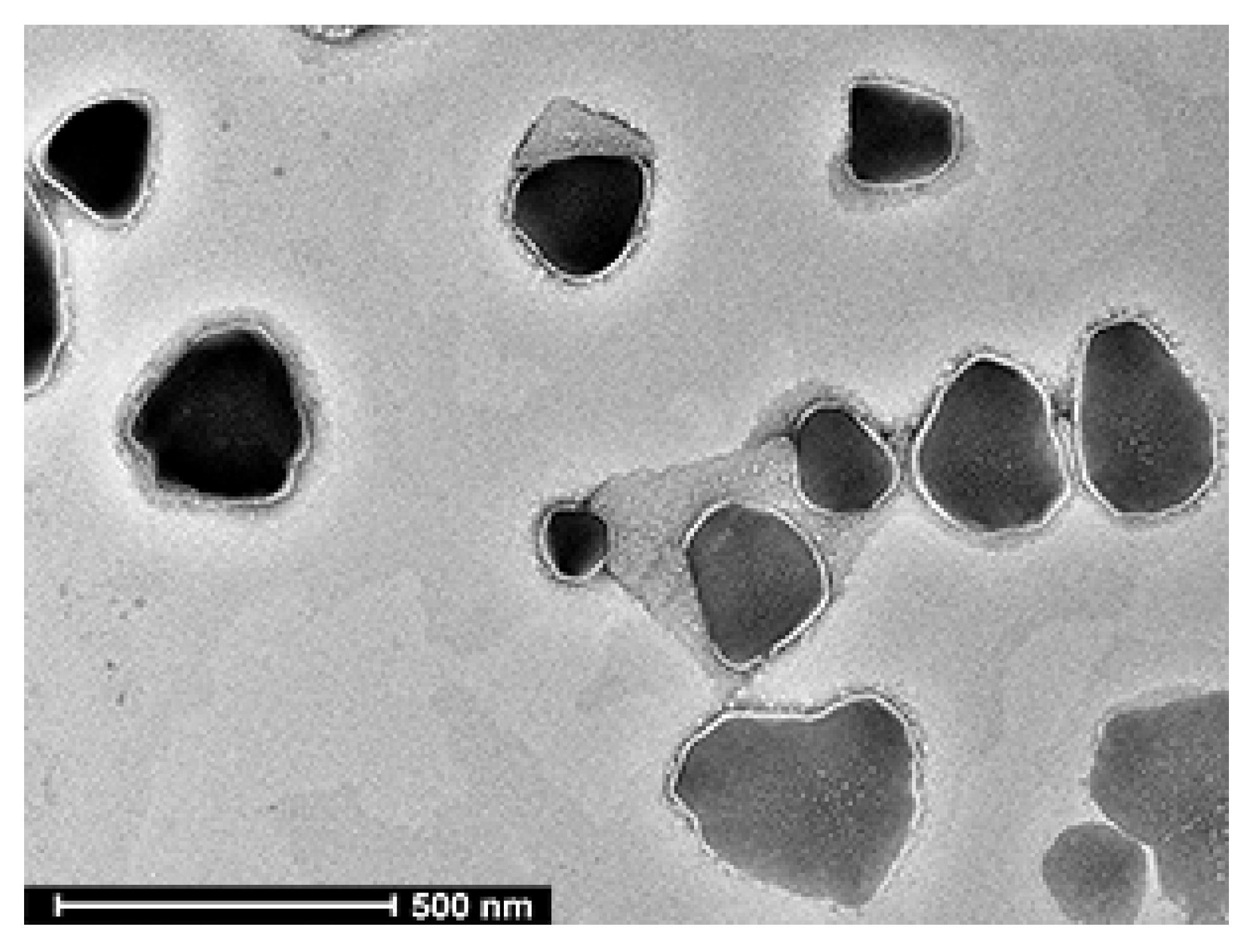
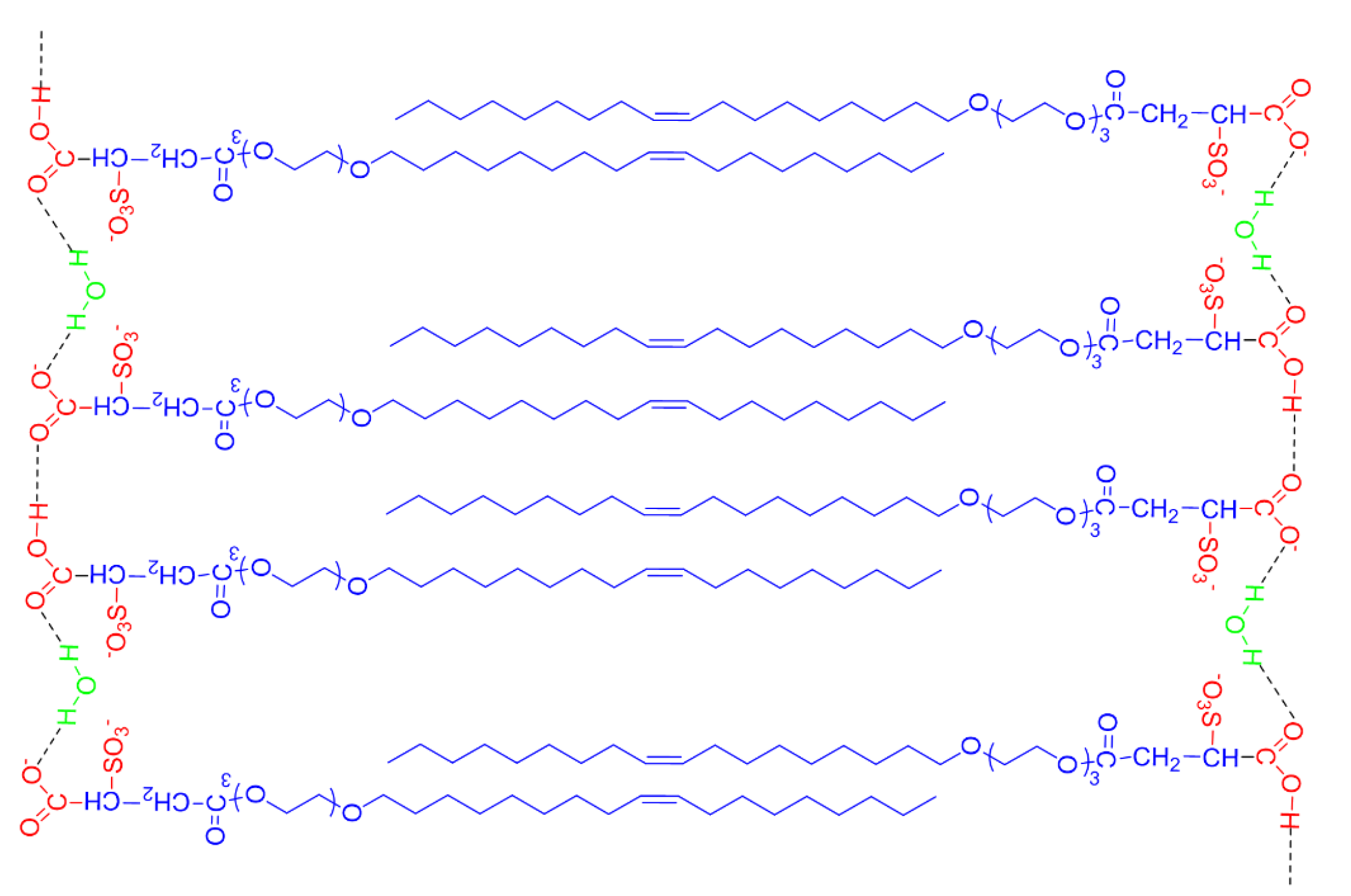
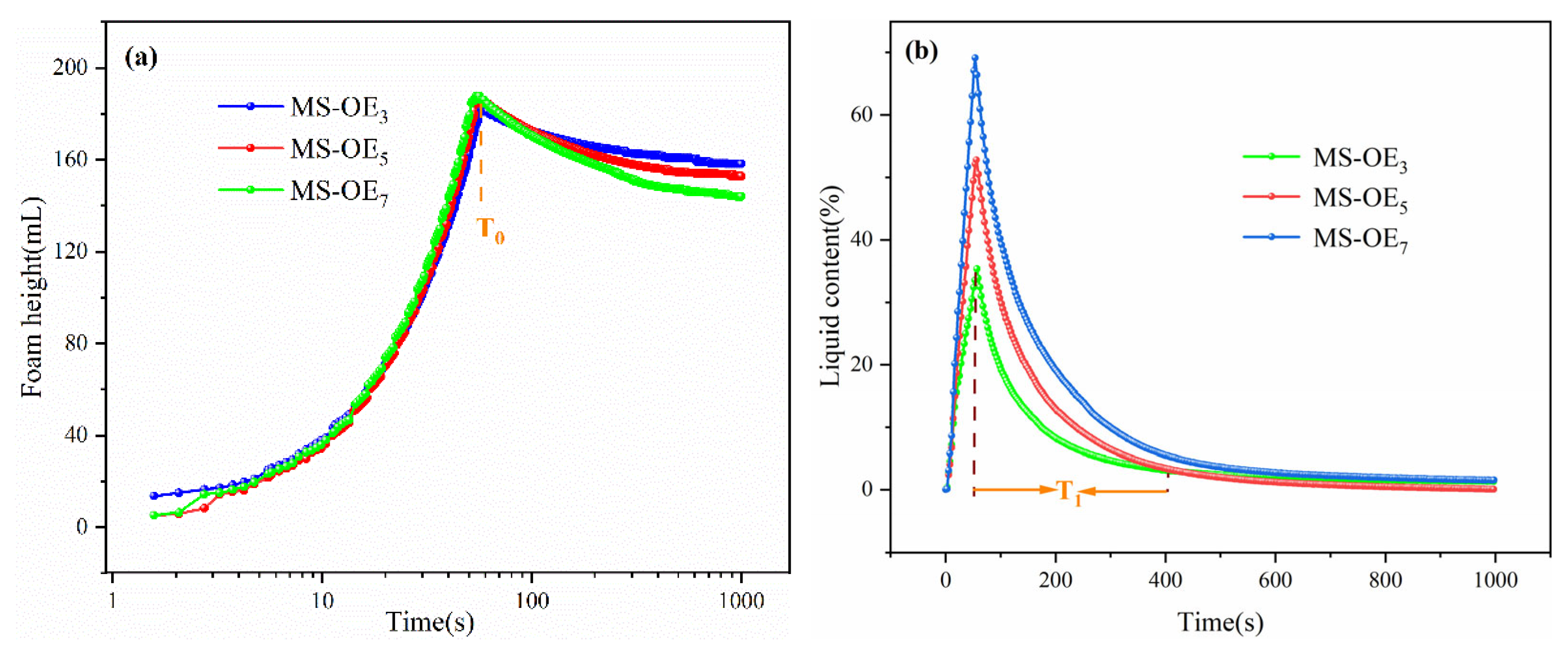
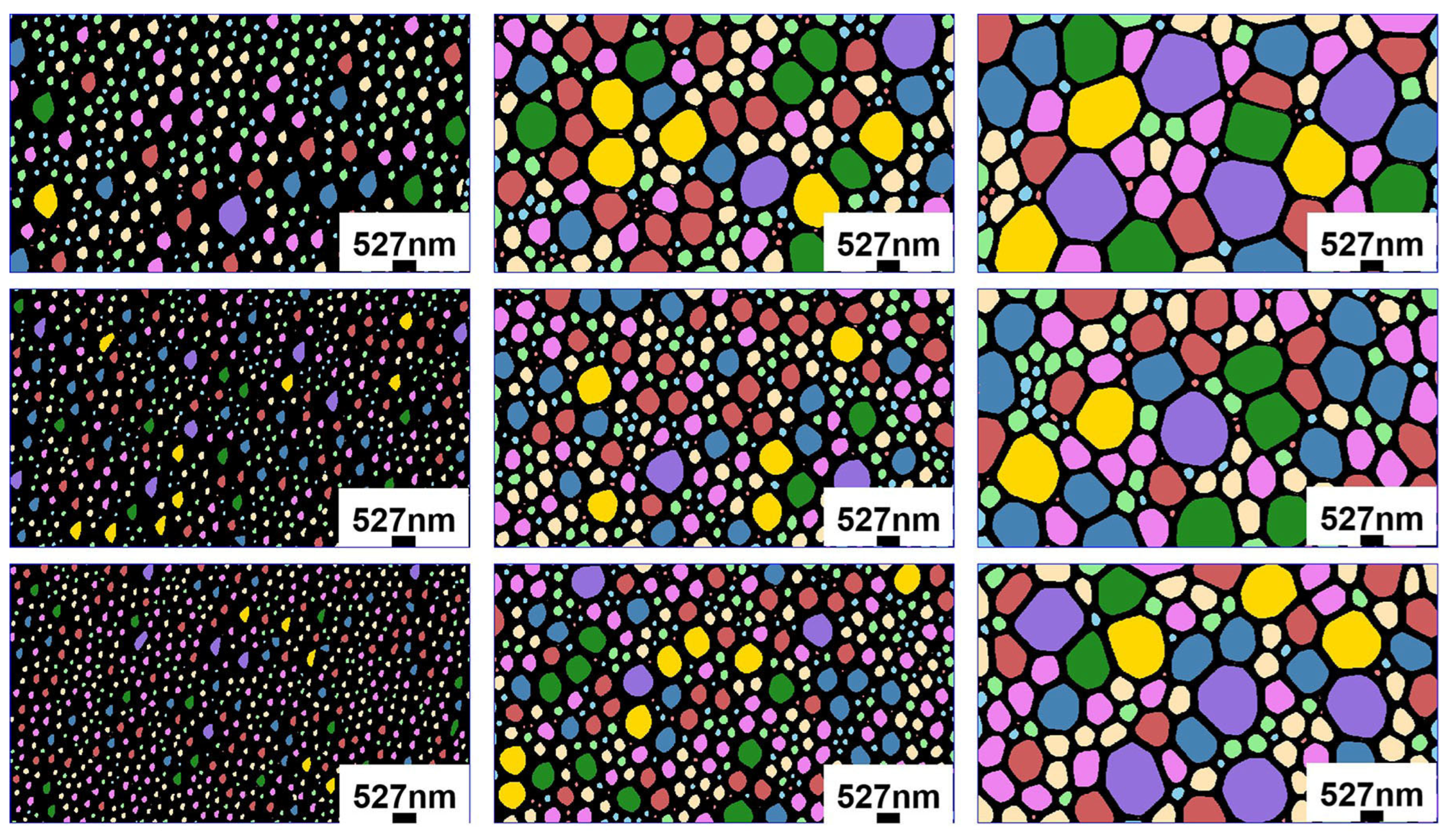
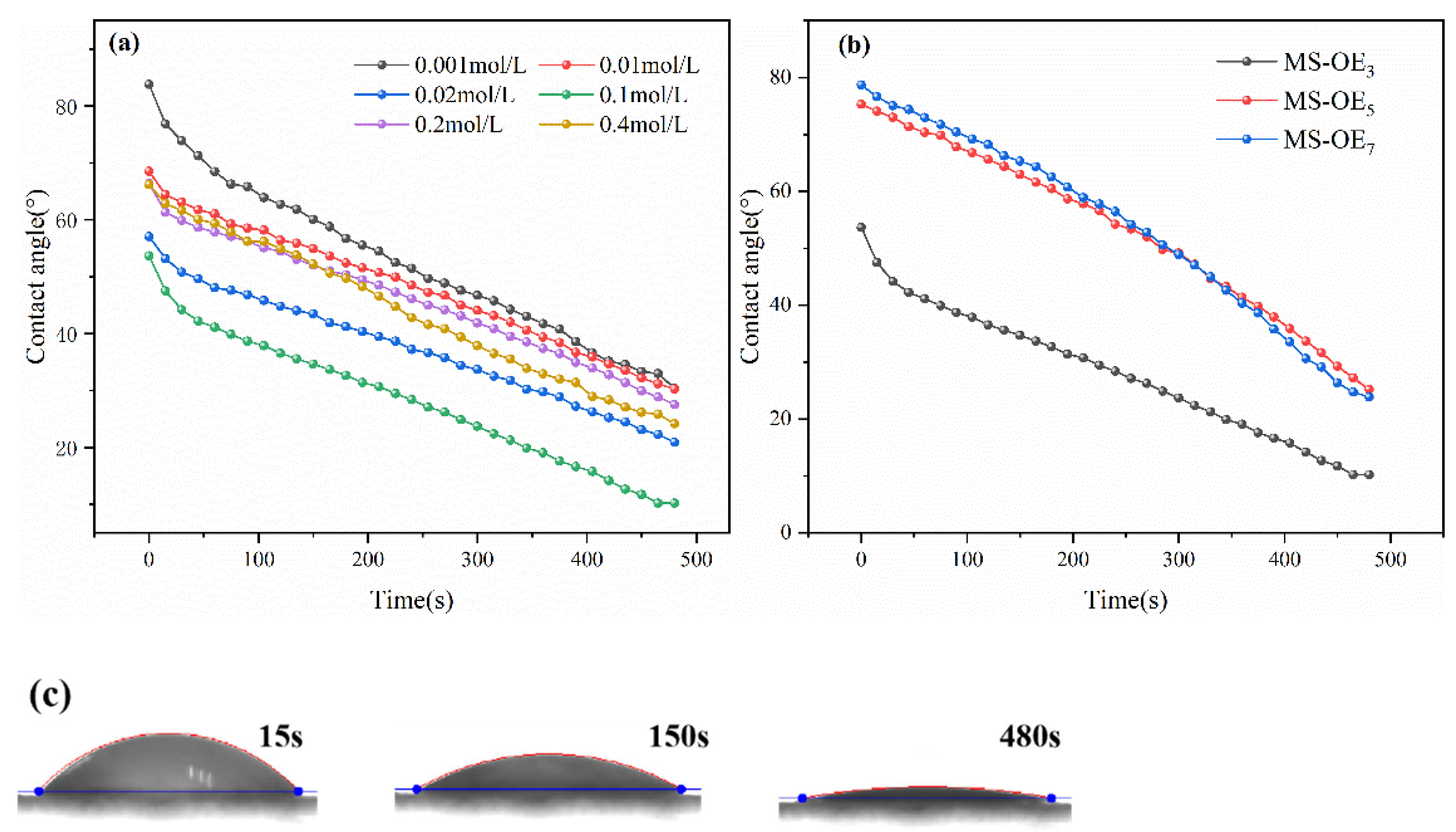
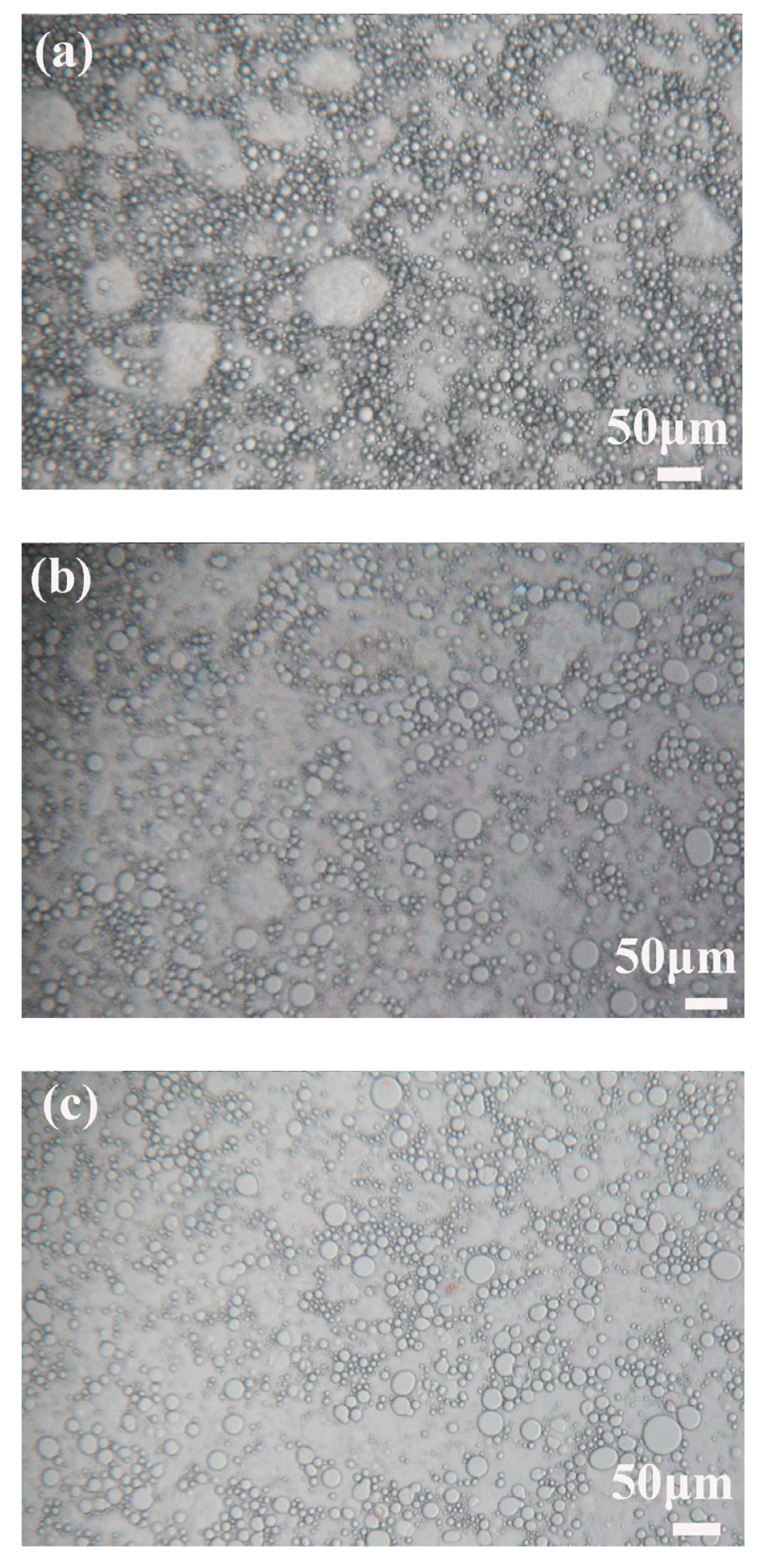
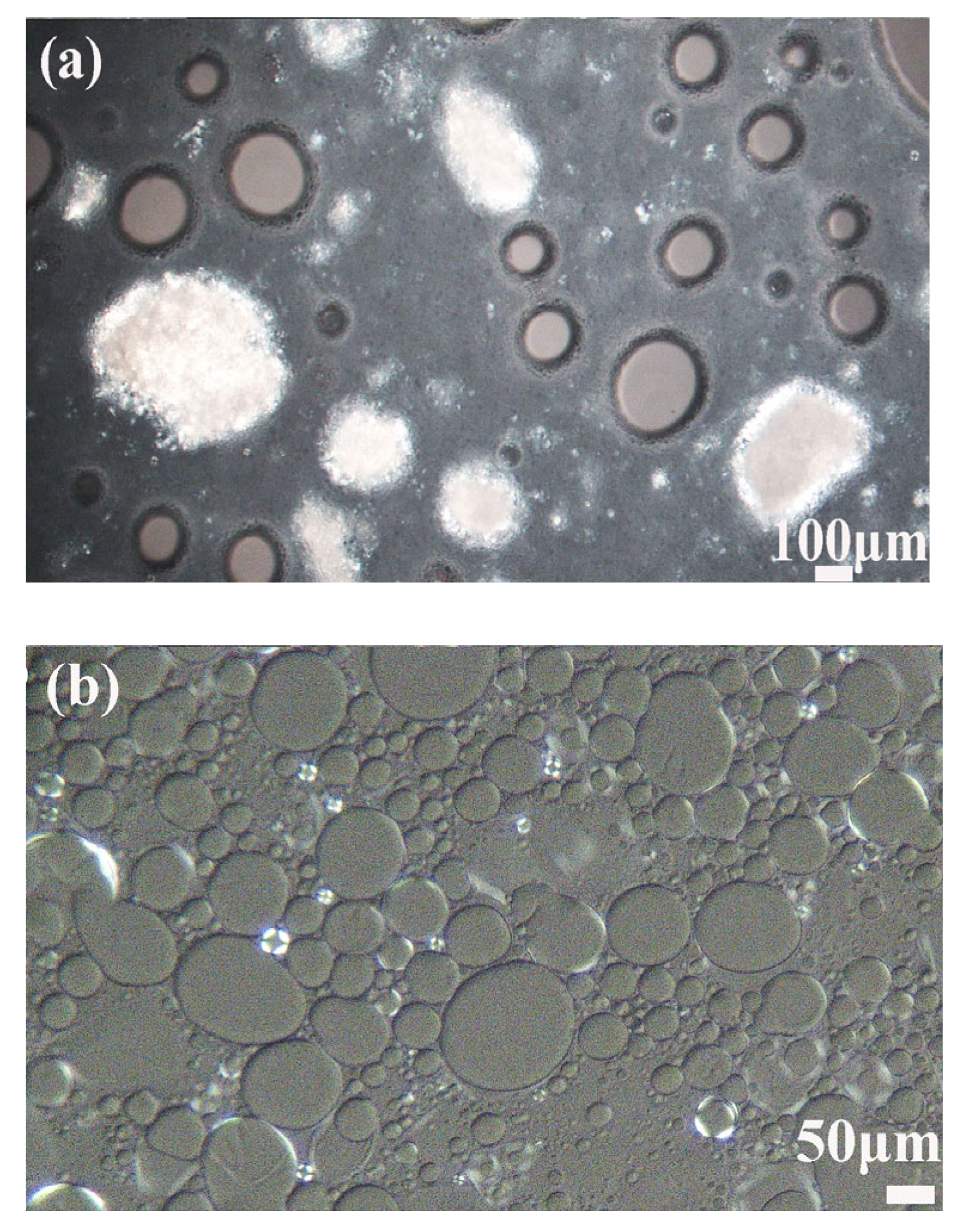
| MS-OEn | cmc | γcmc | Γmax | Amin | ΔGmic | ΔGads |
|---|---|---|---|---|---|---|
| mmol/L | mN/m | μmol/m2 | nm2 | KJ/mol | KJ/mol | |
| MS-OE3 | 17.7 | 37.4 | 0.16 | 10.08 | −11.39 | −291.14 |
| MS-OE5 | 11.4 | 38.8 | 0.15 | 11.10 | −15.82 | −311.58 |
| MS-OE7 | 9.9 | 39.6 | 0.14 | 12.10 | −17.23 | −331.75 |
Disclaimer/Publisher’s Note: The statements, opinions and data contained in all publications are solely those of the individual author(s) and contributor(s) and not of MDPI and/or the editor(s). MDPI and/or the editor(s) disclaim responsibility for any injury to people or property resulting from any ideas, methods, instructions or products referred to in the content. |
© 2025 by the authors. Licensee MDPI, Basel, Switzerland. This article is an open access article distributed under the terms and conditions of the Creative Commons Attribution (CC BY) license (https://creativecommons.org/licenses/by/4.0/).
Share and Cite
Li, P.; Zhang, Z.; Chai, J.; Liu, Y.; Han, S.; Bai, P. Polyoxyethylene Group-Dependent Surface Properties and Aggregation Behavior in Oleyl-Based Sulfosuccinate Systems. Molecules 2025, 30, 2321. https://doi.org/10.3390/molecules30112321
Li P, Zhang Z, Chai J, Liu Y, Han S, Bai P. Polyoxyethylene Group-Dependent Surface Properties and Aggregation Behavior in Oleyl-Based Sulfosuccinate Systems. Molecules. 2025; 30(11):2321. https://doi.org/10.3390/molecules30112321
Chicago/Turabian StyleLi, Ping, Zhengwei Zhang, Jie Chai, Yuan Liu, Siqi Han, and Peixin Bai. 2025. "Polyoxyethylene Group-Dependent Surface Properties and Aggregation Behavior in Oleyl-Based Sulfosuccinate Systems" Molecules 30, no. 11: 2321. https://doi.org/10.3390/molecules30112321
APA StyleLi, P., Zhang, Z., Chai, J., Liu, Y., Han, S., & Bai, P. (2025). Polyoxyethylene Group-Dependent Surface Properties and Aggregation Behavior in Oleyl-Based Sulfosuccinate Systems. Molecules, 30(11), 2321. https://doi.org/10.3390/molecules30112321







